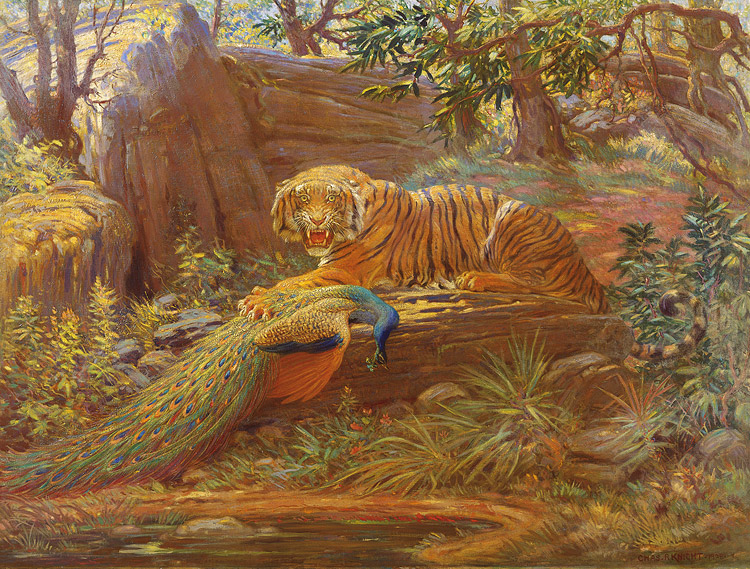…For the tiger, Indian independence, gained in 1947, was a disaster. Researcher George Schaller called it ” a period of destruction that could almost be compared to the slaughter of the American prairies in the 1880′s.” Not only the tiger suffered, but all wildlife and all forests. Added to this, the distribution of antibiotics and shipments of food sent the population rocketing from two hundred and fifty million to four hundred and fifty million in only twenty years.

—The Nawab of Jhajjar astride a pet tiger in his garden, opaque watercolour and gold on paper. Collection of Cynthia Hazen Polsky.
Again and again the artists of the period return to the idyll of the Mughal pleasure garden, a hint of escapism, perhaps in reaction to violent reality. There is a direct parallel to the spirit of Restoration London: after the chill of Cromwell’s Commonwealth, with the theatres closed and festivities banned, society reacted to the enforced puritanism by heading in the opposite direction. In Delhi this was, for example, the age of the great poet-courtesans: Ad Begum would turn up stark naked at parties, but so cleverly painted that no one would notice: “She decorates her legs with beautiful drawings in the style of pyjamas instead of actually wearing them.”….click image for source…
But even before independence, India’s wildlife was in poor shape. Measured from a median point of 1900, almost all Indian wild creatures were in decline. The crackle of the colonial administrator’s rifle echoed from one end of the sub continent to the other. The great Indian rhinoceros, once the sport of royalty, was reduced to a few animals in scattered sanctuaries. The Indian lion, once common over much of the north, was reduced to about a hundred animals in one small forest. The magnificent Kashmir stag was brought down to about several hundred creatures. The buffalo became rare, fewer that two thousand animals.
In 1900, herds of thousands of barasingha were seen by travelers, but fifty years later only four thousand survived. The blackbuck fell to near extinction. The gaur,the chital, and all the other antelope, deer, and grazing animals became shadows of their former selves.

—A national symbol as well as a religious icon, the tiger is seen everywhere in India, including in their currency, stamps, sculpture, paintings, literature and mythololgy. Yet, despite being revered by civilization and religion for thousands of years, the wild tiger is still disappearing at an alarming rate. In counts of 2001-02 the Indian tiger population was 3,642 tigers. The Wildlife Institute of India places the present population at no more than 1,500 tigers, a 2,200 loss.
…
During a 100 year period, from 1850 to 1950, 100,000 tigers were killed by man.
—click image for source….
In this new, population exploding India, the tiger was a sort of wildlife miracle. It was possible because he was a creature of territory, but also capable of migrations of two or three hundred miles. Because he is almost totally a night creature, he can move without detection, and with very little natural cover, from one hunting ground to another. He breeds throughout the year and, unlike the lion, he is fecund, ready to breed at two years of age. A tigress could theoretically produce up to forty youngsters during an average fifteen-year life. ( to be continued)…








 COMMENTS
COMMENTS



